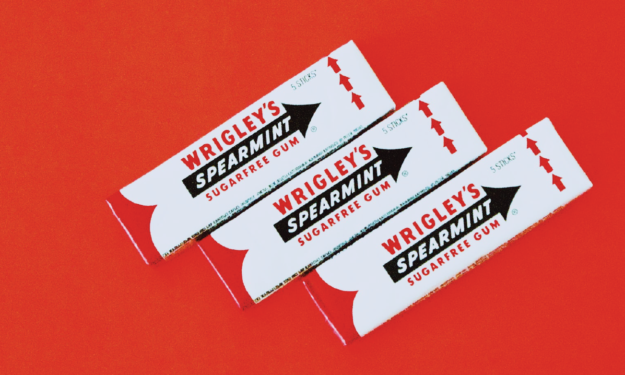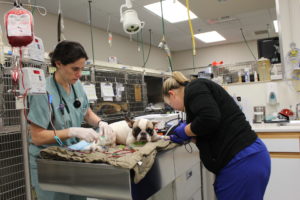Is Xylitol Bad for Dogs?

Xylitol was discovered in the late 19th century and has become widely used as an artificial sweetener. It is made through the processing of polymers that are harvested from hardwood and corncobs. The benefits of xylitol are that is has 2/3 the calories of traditional sugar and has virtually no aftertaste. It also induces very little insulin release and doesn’t require insulin for its uptake into cells, making it a preferred sugar substitute for individuals with diabetes.
What Foods & Products Can You Find Xylitol In?
Xylitol is most commonly found in sugar-free chewing gums. It is also found in many food products, especially those labeled as “low-carb,” and most recently in a few peanut butter brands.
Furthermore, xylitol is a common sweetener used in many over-the-counter and prescription medications. It is not required to be listed as an active ingredient, so it may not always be apparent that it is in the product. Even though xylitol has been shown to be safe for both human and cat consumption, it has severe toxic effects in dogs.
With its inclusion in many food products and its high palatability, accidental xylitol ingestion in dogs is a common occurrence. Xylitol has jumped to the #2 most common call the Pet Poison Helpline receives, just after chocolate. The toxic potential of xylitol in dogs is so high that it only requires a small amount (sometimes as little as a partial stick of gum) before toxic effects are noted.
Here is a shortlist of products that may contain xylitol, and are worth checking the label or keeping far away from your pets:
Foods
- sugar-free gum (many gums are now sugar-free)
- Peanut butter & other nut butters
- Desserts: ice cream, sugar-free cake mixes, pudding, cookies, chocolate, low-calorie baked goods
- Condiments: sugar-free ketchup, barbecue sauce
- Non-fat Greek yogurt
- Sugar-free jams, honey, syrup
Medications
- Cough drops
- Gummy multivitamins
- Oral disintegrating medications & oral liquid medications
- Antacids
- Stool softeners & enemas
- Nasal sprays
Health & Beauty Products
- Deodorant
- Baby wipes
- Facial products: moisturizers & foundation, facial cleansers, facial makeup, makeup remover wipes, body butter
- Oral care products: toothpastes, mouth wash
- Shampoos
- Favored lip balm
Symptoms
Once ingested, the absorption of xylitol is rapid and causes a severe increase in insulin levels. This can occur as soon as 20 minutes following ingestion and can be maximized by 60 minutes. This severe increase in insulin results in a marked decrease in the blood sugar. Symptoms that can be seen when this occurs include:
- lethargy
- vomiting
- weakness
- collapse
- seizures
- and even sudden death
Even though these symptoms can develop rapidly, it is possible for some dogs to have the effects delayed by 12 hours or more. There is also a small population of dogs that don’t experience any of these symptoms.
In addition to having this effect on blood sugar levels, xylitol is also highly toxic to the liver. Liver damage starts developing as soon as one hour following ingestion. Symptoms of liver damage often aren’t apparent until the damage and associated dysfunction are severe, which may not be for up to 72 hours after the xylitol was consumed. This is important to note as dogs that don’t display the symptoms of low blood sugar may not be taken immediately to the veterinarian, resulting in a missed opportunity to intervene and prevent further liver damage from occurring. Once significant liver damage has developed the chances of survival are very low.
Treatment
In the event of an intoxication, vomiting should be induced immediately. This can be done at home using 3% hydrogen peroxide.
Administer 1 teaspoon per 5 pounds by mouth, with a maximum dose of 9 teaspoons per dog. Always call your veterinarian or emergency facility to confirm dosage and let them know what is going on.
The pet can be walked around to encourage vomiting. If vomiting does not occur after 5-10 minutes, then the dose may be repeated a single time. Caution does need to be used when using hydrogen peroxide to induce vomiting as it can cause ulceration of the stomach. If you do not have means to induce vomiting at home, then seek immediate veterinary attention so that vomiting can be promptly induced.

Admission to a 24-hour emergency hospital is recommended following xylitol exposure (even if you induce vomiting at home). The treatments that will be provided include IV fluids to help remove xylitol from the circulation, liver protectant medications, and IV sugar supplementation to treat low blood sugar if present. Activated charcoal is often given orally as this will reduce the absorption potential for any xylitol that may be remaining within the gastrointestinal tract. If severe liver damage has developed, then more intensive treatment options would need to be instituted. While in the hospital blood work is performed frequently to monitor the blood sugar, liver values, and other values that can become abnormal with developing liver failure.
Prognosis
The prognosis following xylitol exposure is good in most dogs when veterinary attention is quickly sought. This good prognosis includes dogs that experience low blood sugar events or have developed mild elevations in their liver values. Dogs with more significant liver value elevations or fulminant liver failure have more guarded to poor prognoses. It is important for dog owners to be aware of this common toxic risk to their pets and to have the knowledge of what to do in the event that an exposure occurs.